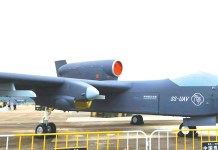The United States is concentrating on enhancing its air defense capabilities in cooperation with industry partners to combat the threat of adversarial missiles. Experimental testing has led to a key breakthrough in American air defense in one such collaboration.
In a test conducted by the Strategic Development Planning and Experimentation Office of the Air Force Research Laboratory, three distinct types of missiles were launched from a single open-architecture National Advanced Surface to Air Missile System (NASAMS).
The “layered” test demonstrated how the NASAMS might protect air bases against cruise missiles at different ranges. The test outcomes were disclosed by Raytheon Missile & Defense to the media on September 7, 2022. The test was hailed as a one-of-its-kind air defense experiment.
“We demonstrated how integrated defense solutions enable the warfighter to deploy the right effector at the right time and target. Using fielded systems, our goal is to provide customers the quickest, most effective way to protect their people and critical infrastructure with layered cruise missile defense,” said Wes Kremer, president of Raytheon Missiles & Defense, in a press release.

It has long been contended by the US State Department that China and Russia are way ahead in missile modernization programs, necessitating a layered missile defense.
Further, China has developed long-range missiles that could strike and destroy the American air bases in the Indo-Pacific, with Guam’s Anderson Air Base in the firing line.
⚡️Air Force: New Western air defense systems will enable Ukraine to shoot down more advanced Russian missiles.
The U.S.-supplied NASAMS and German IRIS-T air defense systems can even shoot down Iskander missiles, Ukrainian air force spokesperson Yuriy Ihnat told RBK Ukraine.
— The Kyiv Independent (@KyivIndependent) September 9, 2022
The US also has assets spread out over the region, with air bases in Japan and South Korea. The Philippines recently also indicated that it would expand American access to its airbases in case of a conflict in the Taiwan Strait. Against that backdrop, strengthening air base defense becomes imperative.
Twelve countries already use NASAMS, and “time and time again, regardless of whether we’re in Europe, the Middle East, or somewhere out there in [the US Indo-Pacific Command area of responsibility], this solution marries itself up very nicely for the threats those particular customers are facing,” said Joe DeAntona, Raytheon’s vice president of requirements and capabilities for land warfare and air defense.
The Air Force Research Laboratory wanted to evaluate “low-cost, high technology readiness level capabilities that could provide near-term air base air defense capability,” said Jim Simonds, the lab’s program manager for the experiment, in a statement.
The test was planned and conducted in only ten months. Simonds asserted that the “layered defense solution could provide the immediate defensive capability.”
NASAMS And Three Missiles
Using US Army radars and the Battle Space Command and Control Center, or BC3, constructed by Raytheon Solipsys for the US Air Force, this intricate experiment evaluated NASAMS’ operational capability to fire the three different missiles.
NASAMS (Norwegian Advanced Surface to Air Missile System) is a medium to long-range air defense missile system developed by Kongsberg Defense, Aerospace, and Raytheon. It is known for using Advanced Medium Range Air-to-Air Missile (AMRAAM) but is also compatible with longer-range missiles like Patriot.
Furthermore, it is also operational with command and control of a range of guns and short and medium-range missiles.
The shortest-range option for the test was the AIM-9X Sidewinder, the mid-range option was the Advanced Medium Range Air-to-Air Missile (AMRAAM), and the longest-range option was the AMRAAM-Extended.

The test was carried out in Norway’s Andoya Air Station, north of the Arctic Circle, by Kongsberg Defense & Aerospace, a partner of Raytheon in developing the NASAMS.
This intricate test determined whether NASAMS could launch three missile versions when connected to US Army radars and US Air Force’s operationally fielded command and control capability, the Battle Space Command and Control Center, or BC3.
The radar initially transmitted targeting information to BC3 during the demonstration, and BC3 then transmitted crucial data to the KDA Fire Distribution Center for threat and weapon assignment.
With the aid of the NASAMS multi-missile canister launcher, the operator in the FDC closed the kill chain by selecting and launching the most powerful missile.
The test proved that forces could “operate globally with a variety of sensors,” according to John Norman, vice president of requirements and capabilities for air power at Raytheon.
The system’s open architecture “allows us to bring in not just the current, existing sensors, but all future sensors and future [command and control],” he added.
Considering the Air Force’s perspective, it’s “got to be able to protect these airfields,” Norman said. “We can’t pick up and move them. We can disperse forces, and we can play that shell game to a point, but we truly have to have the ability to protect our bases because the supply chain will go through there,” he added.
The Air Force Research Laboratory stated that the complex test and the conflict in Ukraine are not connected, as the contract to execute the test was awarded before Russia launched an invasion of Ukraine. According to a fact sheet, the US had sent eight NASAMS systems to Ukraine as assistance as of September 8.
- Contact the author at sakshi.tiwari9555@gmail.com
- Follow EurAsian Times on Google News




